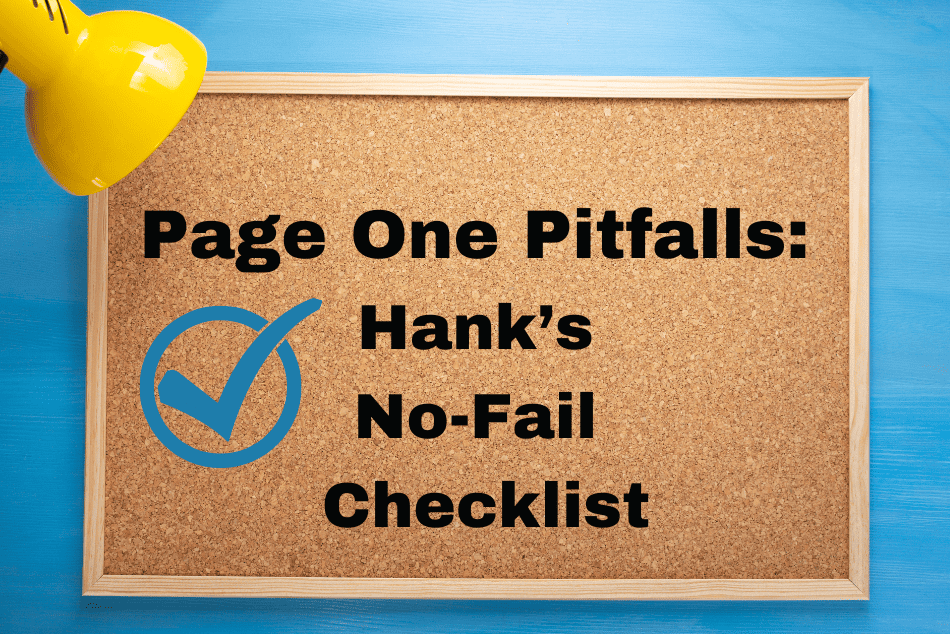How do you make your first pages shine? How do you prevent them from getting instantly deleted by an agent or editor? For me, one of the joys of reading other people’s first pages—and a constant revelation– is seeing how many authors, often working on their first manuscripts, make exactly the same errors.
It’s almost reassuring, though, because every one of these common errors is easily fixed. Or at least… easily recognized.
I just completed two separate in-person sessions with new authors, and as a result, just read more than two dozen works in progress. And it was such an education for me, as it is every time.
They say you can only learn from experience, but hey–it does not have to be your own experience!
We can learn so much from other authors’ first pages. Not only to recognize what they’ve done improperly, but to make sure we don’t do the same thing.
Here are the top mistakes I discovered –or rediscovered– in these two classes. Almost every manuscript was guilty of all of them! If you read about them now, you won’t make them on your own pages.
Format matters
It may sound trivial, and it may feel petty, but pages that are not properly formatted are so annoying to read that agents and editors will frequently delete them. It’s just no fun to attempt to plow through the work of someone who clearly has not done the slightest bit of research into how a page is supposed to look. Formatting makes editors and agents comfortable, and reassures them that you are careful and caring. So:
Make sure each page has a header with your name and the book title.
Number the pages. What if they get printed out, then someone drops them? Instead of trying to put the pages back in order, your reader may simply throw them away.
Each new character gets a new paragraph. But you don’t need an extra line between paragraphs.
And don’t cheat on the number of words that are requested. Don’t make the font smaller, don’t make the margins wider. One thousand words is one thousand words. Three pages is three 250-word page of Times New Roman 12. And every professional can tell. (And it shows you can’t–or won’t–follow directions, right? That’s a big minus.)
Punctuation matters
Learn how to punctuate. Learn where double quotes go, and where single quotes go. Our Dana Isaacson can help.
Don’t do anything cute. There’s almost never a reason to use ALL CAPS. (Nope, not even WOW or BOOM.)
Cut the exclamation marks. (I say—you get one per book. See if you can do that.) And never ever use two in a row!! I mean—never.
Beware of backstory
I saw so many great first paragraphs, brilliant and suspenseful and original. And then, paragraph two was a massive backstory dump. Oh, I thought–I don’t need to know all this right now!
Feed out backstory throughout, and never ever just plop it all into the first page, trying to make sure the reader knows every single thing about your character and their motivation.
If you and I went out to lunch, and I said to you: “Listen to what happened today!” Would you say: “No, I can’t hear that, first I have to know everything that happened to you in the past.” No, of course you wouldn’t. You’d just say: “Tell me what’s new.” Do that on your first pages.
Introduce the main character
Really. Let us know who we’re going to be on the train with for the next 385 pages. (We’ll talk about prologues here.)
Don’t try too hard
The story is of paramount importance. So many writers have a wonderful story to tell, and then they decide to be super descriptive, or use big words, or create unnatural dialogue where people talk the way no one would ever talk. A good book should feel like it isn’t written– like it’s seamless and natural, and it almost sprung effortlessly into existence. Just tell a good story.
Don’t over describe
Have you ever looked in the mirror and thought: oh, my long dark hair is disheveled, and my cornflower blue eyes look especially sparkly today. No, of course not. We do not describe ourselves to ourselves. It’s the sign of an amateur to write something like: I tossed my long blonde hair, and adjusted my magenta sweater. Physical characteristics of people in your book can evolve gradually as the book progresses.
Don’t forget about setting
As every book opens, the movie in the mind of the reader should start to play. If we don’t know where the character is, and where this story is taking place, and when, how will that movie play? The reader will be hearing dialogue in a black void. Make sure you instantly give the reader a visual of where and when. What world are we in? Imagine your book as a movie–how would that first scene look? Make sure the reader understands that. And not just once on the page–there’s no story without setting.
Watch your point of view
No second chances with this. Slipping point of view is an instant and easy reason for rejection. Read all about that here. And here. Truly. This matters.
There’s much more that goes into a first chapter, of course, certain elements that every single first chapter needs. In an upcoming post, I’ll go through a first chapter paragraph by paragraph and illustrate explain why each one was written, and what work it’s doing.
Until then, do you see pitfalls on first pages you read? What are they? Let’s talk about them on the Career Authors Facebook page.





